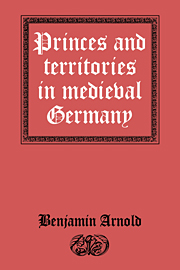Book contents
- Frontmatter
- Contents
- Acknowledgements
- List of abbreviations
- Introduction
- PART I CROWN AND PRINCE
- PART II PRINCELY TITLE AND OFFICE
- 4 The imperial house; German bishops and abbots
- 5 Dukes and duchies
- 6 Counts and the transformation of counties
- 7 Margraves, counts-palatine, burgraves, and landgraves
- PART III DYNASTIES, PRELATES, AND TERRITORIAL DOMINION
- Conclusion
- Index
4 - The imperial house; German bishops and abbots
Published online by Cambridge University Press: 03 December 2009
- Frontmatter
- Contents
- Acknowledgements
- List of abbreviations
- Introduction
- PART I CROWN AND PRINCE
- PART II PRINCELY TITLE AND OFFICE
- 4 The imperial house; German bishops and abbots
- 5 Dukes and duchies
- 6 Counts and the transformation of counties
- 7 Margraves, counts-palatine, burgraves, and landgraves
- PART III DYNASTIES, PRELATES, AND TERRITORIAL DOMINION
- Conclusion
- Index
Summary
Before turning to the major questions surrounding the extension and authentication of princely rights in the German regions, we need to know more about the princes as individuals, what their titles and rank meant in terms of prestige and practice, and the significance of their membership of kindreds, families, and dynasties. As we have seen, princes met with each other and with the king at the scheduled gatherings of the royal court in its perambulations about the kingdom. There was an enormous muster of this kind at Mainz in 1184, when Frederick Barbarossa celebrated the knighting of two of his sons, Henry VI and Duke Frederick of Swabia, amidst ceremonies long remembered for their magnificence. But these meetings were by no means free of trouble. Some of the buildings which the court frequented were perilously ramshackle. In 1132 Lothar III's palace at Altenburg simply fell down about the princes' ears, ‘but by the grace of God everyone escaped unhurt’. At Erfurt in 1184 the floor gave way; several princes were amongst those crushed to death in the rubble, and two counts were drowned in the adjacent sewer. Henry VI and his immediate attendants happened to be standing in the window embrasure of a main wall. They clung to the frame, and were rescued by ladder. During the crowded and unruly hearing before Henry VII in Nuremberg Castle about Archbishop Engelbert of Cologne's assassination in 1225, one of the staircases collapsed and more than forty persons, some of them princes and prelates, lost their lives.
- Type
- Chapter
- Information
- Princes and Territories in Medieval Germany , pp. 77 - 87Publisher: Cambridge University PressPrint publication year: 1991



